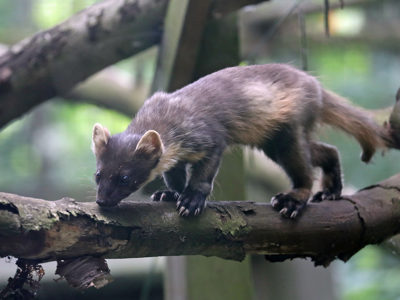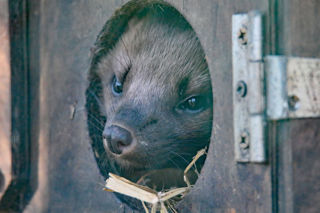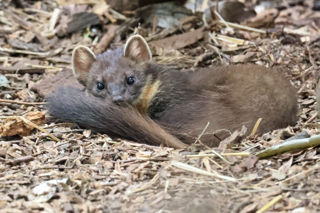
Pine Marten
Martes martes
Pine Martens are members of the mustelid family (which includes weasels, badgers and otters). Around the size of a domestic cat (1.5-1.7kg), they are a long bodied animal, with light to dark brown coloured fur. Markings on their throat, often called a “bib” can range in colour from cream to orange coloured. These bib patterns can be used to identify individuals. Their tails are long and fluffy in appearance. They also possess long claws enabling them to be excellent climbers.

Behaviour
Solitary and can be highly territorial (particularly during breeding season) and territories are marked with scats (faeces). Agile and skilful climbers, although they hunt mostly on the ground. Their dens are normally in fallen roots or hollow trees.

UK Status
Historically, had a wide UK distribution and was in fact the second most common carnivore in the UK during the Stone Age. By the 1800’s, the population had become absent from England and Wales. Currently their stronghold is still Scotland (around 3,500). They are still incredibly rare in England and Wales, with a few small populations surviving and recolonising areas in Northumberland and Cumbria.
Re-introduction projects using translocated Scottish animals have occurred in both England and Wales led by Vincent Wildlife Trust.
Listed as a Biodiversity Action Plan species (BAP); a status that offers protection and conservation plans in order to halt or reverse their decline. They are also fully protected under Schedule 5 of the Wildlife and Countryside Act 1981.

Threats
Due to their territorial nature, pine martens can prove difficult to breed in captivity. Wildwood has successfully bred a large number of pine martens and is continuously progressing their breeding and captive husbandry knowledge through research of our captive animals. To find out more, visit our conservation page.
Distribution
Wide European distribution, across into Asia (including northern Iran and western Siberia). Also found on islands in the Mediterranean.
Habitat
Woodland; known to inhabit both coniferous and deciduous woodland as well as scrub. Woodlands with incomplete canopies and dense undergrowth seem to be optimal.
Diet
Predominantly carnivorous with loose seasonal herbivorous feeding habits. Prey animals include small rodents, birds, invertebrates, eggs and carrion. Seasonally they eat vegetation; berries and fruits are important during the autumn months. Nuts and some fungi are also known to be consumed.
Potential as a valuable tool in the control of grey squirrels within the UK as they seem to predate grey squirrels over red squirrels in areas where they coexist.
Wildwood inside information
Due to their territorial nature, Pine Martens can prove difficult to breed in captivity. Wildwood has successfully bred a large number of Pine Martens and is continuously progressing their breeding and captive husbandry knowledge through research of our captive animals. To find out more, visit our Conservation projects page.
Family facts
- Pine Martens are the only mustelid with semi-retractable claws, crucial for their arboreal nature.
- Pine Martens have adopted a breeding strategy called “delayed implantation”. This means the fertilized egg doesn’t enter the uterus until 7 months after mating. This ensures that at the time of year in which the kits are born, food is plentiful.

